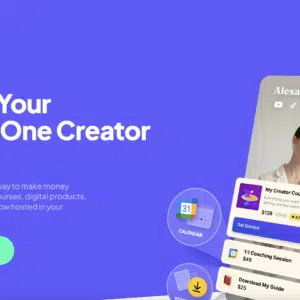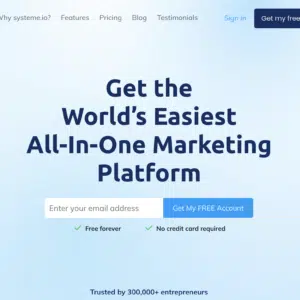It feels like the internet is ablaze with talk of a gold rush on Amazon. You can’t go one day without seeing a news article about the growth of Amazon’s FBA program and the millions of sellers flocking to the platform. Warehouse after warehouse is being built across America. Fleets of drones are being prepared to make 8-hour delivery a reality. Customers on Amazon continue to balloon. There is no end in sight. In some ways, Amazon is just getting started.
So, what is Amazon FBA, and how can it benefit people looking for another stream of income? Say goodbye to franchising and falling for multi-level marketing schemes. Amazon FBA businesses are real, attainable, and allow people to work from home.
Today, I’ll break down the basics of Amazon FBA and how to get started yourself and be well on your way to making an extra $1000/month and hopefully (eventually) $100 per day. Let’s get this party started!
Amazon FBA in a Nutshell
Table of Contents
- Amazon FBA in a Nutshell
- How Does Amazon FBA Really Work?
- Why Amazon FBA Is a No-Brainer
- Multi-Channel Fulfillment Is Your Best Friend
- Private Label and Why It’s Your Path to Freedom
- So, What Is a Private Label?
- How to Find a Product to Sell on Amazon FBA
- Follow These Key Guidelines for Amazon FBA
- Sourcing Basics for Dummies
- Journey to Your First $1000 Month
- Reinvesting Profits
- Wrapping Up
First, it’s important to go over definitions to ensure there is no confusion later on. The “FBA” in Amazon FBA means “Fulfillment by Amazon.” At its core is a mission statement that is relatively simple: “You sell it, we ship it.” It’s rather incredible what Amazon has done with their fulfillment network and warehouses.
If you YouTube “Amazon FBA robots,” you will be amazed. It’s one efficient, well-oiled machine! Sellers all over the world utilize Amazon’s FBA program to basically store, pack, prep, and ship all of their products to Amazon customers. Amazon also takes care of returns, refunds, and general customer service. It’s a dream come true for e-commerce sellers. Like any fulfillment network, there are drawbacks, but the pros far outweigh the cons. There is a reason why Amazon continues to churn out new millionaires every day.
How Does Amazon FBA Really Work?
Before selling on the Amazon platform, there are a few steps sellers must take. The first, most basic step is setting up your seller account. Make sure you sign up for a Professional Seller Account. The account costs $39.99/month. This unlocks the entire ecosystem for you and would be a good time to get your feet wet and peruse the platform before going further. There are many tabs, and it can get a bit complicated. Spending some time up front simply getting used to where everything is would be a good week-long task.
Creating a New Listing
The next step most sellers take is to create a listing for a new product they are wanting to sell. This is called private label, and we will get into further detail in the latter section of this post. To create your listing, you will need things like a GS1 UPC code, pictures, a title, bullet points, a description, and keywords. Things like pictures and bullet points, you can do yourself or hire a company to do them for you. The key is to write the copy for human eyes, not artificial intelligence. Amazon is getting smarter by the day, and it’s critical that you write for people. Once your listing is complete, it’s time to send inventory in.
Shipping in Products
Sourcing from either overseas or America is broken down in further detail below, but I’ll cover the basics here first. Once you have sent the final payment to your factory, they will pack and label your units and cartons per Amazon’s standards. Amazon has all sorts of rules for this, so it’s critical that you follow their terms of service here.
Once your cartons are ready to go, either you or your factory will finalize shipping. Most sellers utilize air shipping out of the gate since the orders are smaller for new launches. Over time, most transition to using sea shipping containers, as it is much more cost-effective. Your cartons will eventually land at Amazon warehouses and be checked-in. The check-in process is basically Amazon scanning each of your units into their system and organizing your products in bins. When they are fully checked in, you will see the total number of units in your seller central account. Then, it’s showtime!
Amazon FBA = Your Employee
Next up is seeing sales come in while you sit at home and see dollars roll in. In fact, most sellers never physically see their inventory! Everything is so digital and streamlined now. Since you will be using the FBA program, your listing will get the Prime badge automatically. This unlocks Prime 2-day and 1-day shipping for customers since Amazon will be managing the logistics of each order. Customers come to Amazon expecting fast shipping. You won’t have to deal with any order processing, packing, or prepping. You will see the sale come through and any associated FBA fees removed from the sale. From this point on, all shipment tracking and confirmation emails will be sent to the customer. Even order issues like missing packages will be taken care of with Amazon customer support. Bada Bing, Bada Boom!
Why Amazon FBA Is a No-Brainer
Amazon FBA is truly a no-brainer in many ways. Managing your inventory on your own is a royal pain. Amazon has, in one sense, solved almost every complaint e-commerce business owners have. The biggest reasons why Amazon FBA is a slam dunk are time savings and business efficiency. Brand owners prefer spending their valuable time on branding, expanding product lines, and inventory planning. The last thing they want to deal with is fulfillment and the headaches that come along with it.
Multi-Channel Fulfillment Is Your Best Friend
A topic often neglected is fulfillment options outside of Amazon. For the vast majority of sellers I work with, they have a Shopify site and also sell on platforms like eBay and Etsy. Many sellers simply assume that they must sign up with a third-party warehouse to fulfill these off-Amazon orders. WRONG, so wrong. Enter Amazon’s MCF program. “MCF” stands for Multi-Channel Fulfillment. In a nutshell, any order that is placed on non-Amazon sites can be fulfilled using your Amazon inventory. No third-party warehouse is needed. When a customer orders through your Shopify site, for example, the customer won’t know it’s being fulfilled by Amazon until their item arrives in the branded Amazon Prime packaging. In my experience, 99.99% of customers could care less who fulfilled their orders.
Another huge benefit to using the MCF program is that any order fulfilled with this program will have discounted fees associated with it due to not needing to pay the Amazon referral rate. The average is 15% on Amazon and depends on your category. These are huge cost savings! Here is a picture showing some examples of items fulfilled with the MCF program:
The program also allows you to offer various shipping options at checkout on your site: 1-day, 2-day, or 3-5 day delivery options. As a seller, you can choose what to charge for shipping costs, so knowing your MCF fees for the various shipping times makes it easy to know what to charge your customers. Everything is published on Amazon, so feel free to dive deeper.
Private Label and Why It’s Your Path to Freedom
There has always been a great debate on the internet as to what is the best-selling model for Amazon. The clear winner is private label, as it allows you to scale from a modest business to millions of dollars relatively easily, all the while never needing to touch or manage your inventory. Another benefit is the potential for an exit someday. As you grow a private label business, you control the trademark as well as any design patents. You have full control over who is allowed to sell your product, and it gives you the freedom to innovate your product at any time.
So, What Is a Private Label?
Private labels are no different than what grocery stores like Costco or Kroger do with their own branded items. For example, if you go to the peanut butter aisle, you will see a large selection of options, but you will also see Kroger brand peanut butter. Selling private labels on Amazon is no different. You aren’t reinventing the wheel; you are providing similar products in an existing category using your own product packaging and logos. The beauty of private labels is that this is a brand that YOU own. You aren’t simply reselling someone else’s products. With your own branded products, you have total control over the product features, whether you sell color variations, listing details, types of media, and whether you want to consider an exit someday. I call it the dream model because it just is.
How to Find a Product to Sell on Amazon FBA
This is where most people go south. The harsh reality is that most fail on Amazon due to improper upfront product research. Most go with their gut or chase seasonal items. The worst is chasing trending items like face masks. Thanks, Covid! Instead of chasing trends, chase evergreen products. Evergreen products are sold year-round, 365 days a year, with no end in sight. Examples of evergreen products include things like phone chargers, kids’ toys, and office supplies. Those are just a few. The vast majority of what is sold on Amazon is considered “evergreen.”
Follow These Key Guidelines for Amazon FBA
There are gurus and supposed “teachers out there giving all sorts of terrible advice to new sellers. It’s a shame because the process of finding a product to sell doesn’t need to feel like a complicated science experiment. If you follow some simple guidelines, you will stay out of trouble and be well on your way to finding not only your first product to sell but launching your first BRAND!
Rule 1: Find a product you have a passion for that will lead to an established brand with multiple product lines. What will inspire you to put in the long hours at night working on your business?
Rule 2: Does the product bring some innovation to the market or solve a need? Simply selling a new color of an existing product is not going to cut it. Anyone can do that.
Rule 3: Is the product low-risk for the end user? No to knives. No to supplements. No to makeup or skincare products. Avoid things that could lead to adverse reactions or injury. To make matters worse, risky-type products often have brutal selling environments and are not advisable for new sellers.
Rule 4: Is the product smaller than a shoebox, light weight, and sells for more than $40? The key here is not to get tied down by storage costs. Focusing on premium, small products is the secret sauce on Amazon. The $40 target sale price is tied to less competition. As you target higher-priced products, there is typically a drop in competition. Most sellers on Amazon focus on products under $20. Avoid these at all costs.
Rule 5: Does the product have a bare minimum net profit of 25%? This net profit is calculated as follows: (target selling price) – (manufacturing cost + shipping cost + tariffs + Amazon FBA fees + storage fees + PPC fees). The main reason you want to get this math right and target 25% net profit from the get-go is to allow for a reduction in price down the road and still maintain strong margins. The reality is that this inevitably happens as more and more competitors show up.
Rule 6: Does the existing competition have room for another seller? If you see tons of sellers with thousands of reviews, then obviously, it’s not a good category to sell in. The key is to find a potential product with maybe one existing seller with over a thousand reviews and the rest with a few hundred. Chasing competitors with hundreds of reviews is easy, but chasing a sea of competitors with thousands is a nightmare.
Rule 7: Is there a nice, even revenue spread across the existing sellers? To clarify, what you want to avoid is a monopoly seller accounting for 80%+ of the total revenue in the category. This means the seller has been around for years and is bidding an obscene amount of money per click for advertising. They basically have a corner in the space. Run! What you want to see is maybe a top seller doing 20%, then the other 80% split across many sellers. Going up against goliath from day 1 is never advisable.
Rule 8: Are these existing patents for the product idea? If yes, then this is an automatic no. Patents can take two forms. A utility patent covers the original idea of the product. This will be obvious, as there will most likely be only one listing. The second type of patent to look out for is a design patent. This is a bit harder to evaluate, as some sellers keep this information hidden. A design patent protects a seller’s unique design, not the original product idea. A simple Google patent search can find these, as can a lawyer for a modest fee.
Rule 9: Is the product that would lend itself to being successful on social media? This is something that’s very important to understand from day 1, as Amazon will NOT be the only place you will sell. Eventually, you will be selling on your own website, eBay, and others. To drive traffic to your own website, for example, your product needs to be able to be showcased and used in a visual way that customers will understand in under 15 seconds. The product should have an obvious purpose and be able to deliver your brand’s mission statement through video production and beautiful photography with models.
Rule 10: Is the estimated sales volume between $25k and $100k? On Amazon, this is the sweet spot. This is in part because of competition. When you get into products doing over $100k, the competition is fierce, and sellers play extremely dirty. I have found it’s better to stay under the radar and focus on launching multiple products under $100k and scaling this way. It’s much less risky than targeting higher-volume products.The only tool you really need is something like Jungle Scout or Helium 10. These are powerhouse software programs that tell you everything from the estimated monthly sales volume to the search volume of the listing. I prefer Jungle Scout due to it being a little more streamlined and easier to use. But both are great for anyone starting out.
The only tool you really need is something like Jungle Scout or Helium 10. These are powerhouse software programs that tell you everything from the estimated monthly sales volume to the search volume of the listing. I prefer Jungle Scout due to being a little more streamlined and easier to use. But both are great for anyone starting out.
Key Guidelines for Amazon FBA
| RULE NUMBER | GUIDELINE |
|---|---|
| 1 | Choose a Product You’re Passionate About, Potentially Leading to a Brand |
| 2 | Ensure the product brings innovation or addresses a need |
| 3 | Opt For Products Low in Risk for End-Users; Avoid Hazardous Items |
| 4 | Prioritize Products Smaller Than a Shoebox, Lightweight, Selling Over $40 |
| 5 | Aim for a Net Profit Margin of at Least 25% |
| 6 | Check for a Competitive Environment Without Too Many Established Competitors |
| 7 | Look for a Balanced Revenue Distribution Among Sellers |
| 8 | Avoid Products With Existing Utility or Design Patents |
| 9 | Choose Products That Can Be Effectively Showcased on Social Media |
| 10 | Target Estimated Sales Volume Between $25K and $100K |
Sourcing Basics for Dummies
So, you have spent hours and hours researching and have finalized your first product idea, but now what? Next up is sourcing. Sourcing is a world that is mysterious to most, but it doesn’t have to be. You will find all sorts of “secrets” online as to what is the best way to find a factory. Finding a manufacturer is much easier than people realize! Yes, it takes a lot of effort but, the mechanics of deciding on a factory are relatively simple.
A funny sounding website called Alibaba was king in 2010 and is still king in 2024. There is really no better place to find a factory today. Creating an account is very easy, but be sure to create a dummy email that sounds professional. An example would be [email protected]. Totally made up, but sounds very above board. Overseas factories are going to be analyzing every aspect of your entity on Alibaba, so it’s critical to avoid a Gmail address and really paint the image that you are part of a large organization in the United States.
Next up is creating your RFQ. RFQ stands for “request for quotation.” In a nutshell, you are blasting out a request to ALL the factories on Alibaba requesting pricing proposals for your product idea. Let them come to you! I see sellers make the mistake of hunting and thumbing through page after page of search results, only to never find a quality factory. This is where the RFQ process is your best friend.
But, what do you include in your RFQ message? Well, I’m glad you asked! Here are some things to put into your RFQ to protect yourself:
- Use a name like “Lead Sourcing Manager” in your introduction. Really drive home the idea that you’re part of a professional organization and not a random Mom-and-Pop company wanting to sell on Amazon. You will get better pricing this way.
- Provide your idea and pictures of the product if it already exists. Give as much detail as you can from the very start. Add sketches as needed.
- Add a secret question like “What is 3×4?” in the middle of your message. This will tell you if the factory actually took the time to read your entire RFQ.
- Request that you are not interested in working with a trading company. Only an established factory already doing millions of dollars worth of orders.
- Ask what the sample charge is and whether they will work with you on product tweaks.
- Ask for the pricing of an initial test order of 250 or 500 units.
- Mention that you are wanting to scale FAST, so you’ll need to know their pricing for 1000, 2000, and 5000 units. Feel free to mention that you will be comparing their pricing with other factories so you require their best price up front.
- Ask them if they have an in-house designer and a factory floor manager.
- Ask what their quality control plan looks like.
- Mention that you will be taking care of all shipping on your own, so all pricing needs to reflect EXW (Ex works, supplier’s pricing not including any shipping costs) pricing.
Sourcing Basics
| REQUEST FOR QUOTATION (RFQ) COMPONENTS | DESCRIPTION |
|---|---|
| Title | Position as “Lead Sourcing Manager” for a Professional Image and Better Pricing |
| Product Details | Share Pictures, Detailed Ideas, and Sketches if Necessary |
| Secret Question | Insert a Question (e.g., “What Is 3×4?”) To Check if the Factory Read the Full RFQ |
| Type of Business Partner | Express a Preference for Working With Established Factories Over Trading Companies |
| Sample & Tweaks | Inquire About Sample Charges and Their Willingness to Modify the Product |
| Initial Test Order Pricing | Request Pricing for a Small Test Order, e.g., 250 or 500 Units |
| Scaling & Pricing | Express Intention to Scale Quickly and Ask For Bulk Pricing (e.g., 1000, 2000, 5000 Units), Mention Price Checks |
| In-House Designer & Manager | Ask if They Have an In-House Designer and a Factory Floor Manager |
| Quality Control | Seek Details on Their Quality Control Procedures |
| Shipping & Pricing Mode | State Your Intention to Manage Shipping and Request EXW (Ex Works) Pricing |
Next is a barrage of responses from suppliers. Don’t be surprised if you get 30-50 messages back. How they respond and what they respond with in their message will tell them a lot about them as a factory. Right out of the gate, you will probably find that 25% of the suppliers are just not worth the time to respond to. Focus on the factories who answered each of your questions and are professional. There will be hundreds of back-and-forth emails with these factories. This process just takes time so be patient.
The goal is to narrow down your list to a top five factory list. From there, you’ll want to get it down to three. At this point, you will move forward with each factory and have samples made of your final product. Once you get each sample, stress test them over one to two weeks, then make notes on each sample and respond to the three factories. After you accumulate this data, you will have a good sense as to who you want to work with. The factories that really stand out are those that are quick to respond, have strong English, and make obvious efforts to win your business over.
Once you agree to move forward with a factory, make it your goal to get them to agree to 30/70 terms for payment for your first order. What this means is that you will pay the factory 30% of the purchase order up front to get the production started, then pay the other 70% once production is complete. However, the 70% should only be paid if the factory has provided ample pictures to confirm that it is indeed finished. Production takes 4-8 weeks, depending on product size and number of units. In terms of shipping, you can use either air or sea freight. For sea, you will need a freight forwarder to organize all the logistics and take care of customs paperwork.
Journey to Your First $1000 Month
Now that we’ve covered Amazon FBA basics, product research, and sourcing, let’s take a look at a simple case model. The premise of this article is to help people reach an extra $1,000 per month. In reality, it is ridiculously easy to get to this number, but let’s use it to cover the financial side of things. Let’s say you’ve found a fantastic product idea, vetted it, and it’s something you’re interested in. Now, let’s say the estimated monthly revenue of the product is $5,000 a month. Assuming a net profit of 20%, this results in your first $1,000/month product. It is better to launch products with monthly revenue potential in the 25-100k range, as it will allow you to better handle price compression and make it worth the effort to launch.
Reinvesting Profits
Now, many gurus and quacks on the internet will paint this beautiful picture of endless cash flow and being able to take a ton of cash out of your business. The truth could not be more different. Most Amazon sellers that truly thrive are reinvesting the majority of their profits straight back into their brands and product lines. In fact, it’s better to reinvest every dollar of profit back into your business for the first year. This allows you to grow rapidly and focus on expansion early on. Even as you start to pay yourself some money, it should be a modest amount and scale as you grow. So, in one reality, you might be making $1,000 in profit a month but using that same profit to grow your business.
As you continue to launch products, you will see your revenue balloon. For example, when I launched, I made just $150,000 my first year. By my second year, I was making over one million in revenue! This was all a result of launching products the right way and reinvesting my profits.
Wrapping Up
I hope you’ve enjoyed this long-winded breakdown of the Amazon FBA and private label business models! There is so much more that can be covered that this article could easily turn into a book. The FBA world is one full of great successes and many failures. Seeing more brands be successful on the platform is what I live for. Use this guide as a strong foundation as you launch your first product on Amazon. Amazon is truly a never-ending opportunity zone, and there is absolutely no reason why more and more people can’t develop it into a second income or have it become a total income replacement like it did for me.
About Jon and Black Label Advisor
Jon Elder runs Black Label Advisor, a consultancy focused on helping brands expand their business on Amazon and reach countless new customers. Having grown his own Amazon private label business to 8 figures and exiting for mid-7 figures, he has a passion for helping other business owners achieve the same level of success. Black Label Advisor offers a wide range of Amazon consulting services including listing optimization, branding strategy, and logistics improvements. You can contact him by emailing him at [email protected]







